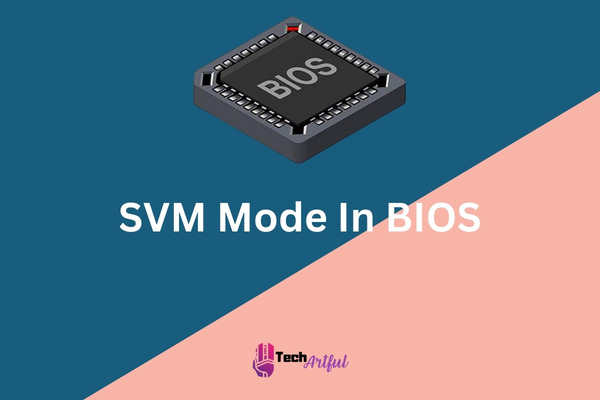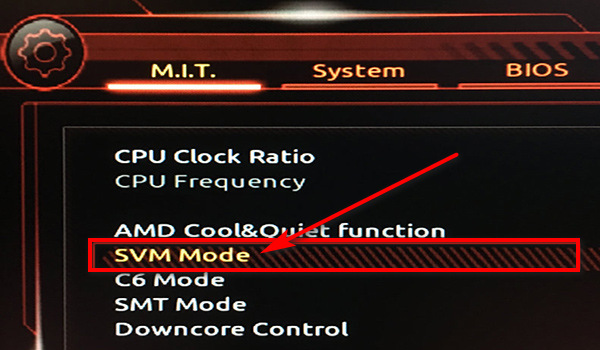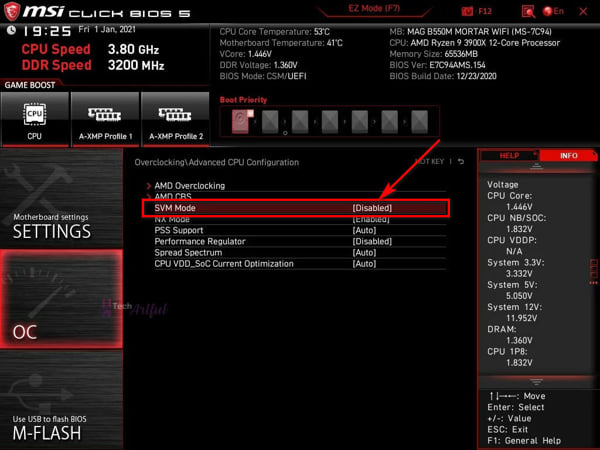Are you wondering what is SVM mode in BIOS? Well, no worries. In this article, we are going to explain this mode, how to use it, the involved risks, and every concern you may have regarding this SVM mode in the BIOS setting.
Secure virtual machine (SVM) mode is a kind of virtualization technology that makes it possible for your computer to serve as a host system, making its hardware resources available to many virtual machines. Therefore, it is possible to run many operating systems on a single computer at the same time if you have a powerful enough machine.
Continue reading because, in the next few sections, I will tell you all there is to know about the SVM mode.
What Is SVM Mode In BIOS
What exactly is meant by the term SVM mode in BIOS? You will be able to locate the SVM AMD option in the BIOS of your computer if you are using a motherboard manufactured by AMD.
A Secure Virtual Machine may be enabled by selecting the SVM Mode option inside the BIOS of an AMD motherboard.
In addition to providing a protected environment for virtual machines, SVM also enables a higher level of direct access to the underlying hardware than is possible without it. Enabling specific BIOS settings such as this one provides several benefits, the most important of which is an improvement in performance while running virtual machines.
The technology is referred to as AMD-V by AMD in addition to being referred to as SVM; hence, your BIOS may mention it under the name AMD-V.
If you utilize Intel processors, the obvious follow-up question is whether or not your BIOS has a feature that is comparable to the one being discussed here.
By using the AMD SVM mode, AMD was able to define its virtualization solution for the x86 architecture. Therefore, in addition to going by the term SVM, AMD also refers to the technology as AMD-V, and that is the moniker that appears when you look it up in the BIOS.
Advice: There is a virtualization technique developed by Intel known as Intel XT-x or Intel Virtualization. This technology works similarly to AMD-V and AMD SVM mode.
Does Enabling SVM Mode Impact Performance
Because SVM mode is a function for operating virtual machines, its impact on performance will only be seen when virtual machines or emulators are being used (like BlueStacks). Therefore, the performance of your computer will not suffer in any way unless you are using such programs.
If you enable virtualization on your computer, the performance of the rest of your PC, even when it is regularly operating, should not be affected. This is because the virtual machine itself uses the computer’s resources.
However, there are conflicting claims concerning whether virtualization options consume more performance or cause small problems when activated. As a result, I wouldn’t advocate using virtualization when it isn’t being actively used because of these concerns.
How does the performance of the Virtual Machine itself compare to that of an operating system that has been installed correctly? Currently,
This can vary depending on several different factors, but generally speaking, because Virtual Machines have very limited or even none at all direct access to the underlying hardware, there is a significant performance penalty associated with running something inside of a VM as opposed to not using virtualization at all.
Emulation and virtualization have certain similarities, but virtualization and emulation are not the same things at all. This is only one of how the two concepts are similar.
Whereas software is used in virtualization to create an autonomous operating environment for a different operating system, emulation employs software to simulate hardware on the host computer. Virtualization may delegate some or all of the host machine’s hardware resources to the guest operating system.
When opposed to the expense of emulation, the performance cost brought on by virtualization is rather insignificant.
In light of the aforementioned, if you have the Hyper-V Windows Feature switched on, your personal computer will operate as a privileged guest regardless of whether or not you run any virtual machines.
In such a case, the performance of your personal computer can suffer somewhat. That is a fault, or more accurately, a defect in the architecture of the Hyper-V Windows Feature.
How To Find SVM Mode In BIOS
Depending on who manufactured your motherboard, the SVM mode may be deeply buried among a variety of various sub-menus. Proceed through the following procedures to locate the SVM mode in the BIOS:
In ASUS Motherboards:
- Turn on your computer.
- Keep pressing the Del key during the boot process, and the BIOS will eventually load.
- Simply tapping the F7 key will take you into Advanced Mode.
- Proceed to the Advanced CPU Configuration option if you haven’t already.
- Locate SVM mode.
In Most Other Motherboards:
- Start the computer.
- Maintain pressing the Del key until the boot-up menu for the BIOS appears.
- Head on over to Advanced.
- Go over to CPU Configuration.
- Locate SVM mode.
So, these were the steps to be taken to enable/disable the SVM mode in BIOS.
What Is a Virtual Machine
A Virtual Machine allows you to run a separate version of an operating system inside software that is installed on your primary operating system. In essence, it acts as an independent copy of the other operating system.
It is not the same thing as having a completely different operating system, which would need a disk partition that is completely distinct from the other partitions on the computer.
By utilizing Virtual Machine applications such as VMWare or VirtualBox, you can run an isolated OS within your primary Operating system without the need to restart to switch partitions or even the need to set up a distinct OS installation partition at all. This eliminates the need for you to set up a distinct Operating system configure partition at all.
One might, for example, apply this to operate a Mac or Linux Virtual Machine inside the context of a Windows operating system.
Can I Turn On SVM Mode In BIOS
As I’ve mentioned before, if you switch on SVM while also having the Hyper-V Windows Feature turned on, there is a possibility that your system’s performance will suffer somewhat as a result.
Except if you execute virtualization operations such as virtual machines or emulators, there is no need to activate SVM since there is no need to do so.
In addition, even if you enable SVM to launch virtual machines, you still need to ensure that your computer has sufficient resources before doing so.
As I explained before, virtual machine functions in the same way as if it were its distinct computer. For it to function, it must have its very own central processing unit (CPU), graphics processing unit (GPU) cores, storage, and available RAM.
The question now is, how do you activate SVM in the BIOS?
The following are the procedures that need to be taken to activate SVM mode in BIOS:
- Pressing the F2 key during a quick reboot will bring up the system’s BIOS screen.
- Navigate to the Advanced menu and choose CPU Configuration.
- Proceed to SVM Mode, and then choose the Enable option from the menu that appears.
- Select the Save Changes and Reset buttons and then press Save & Exit.
When Should You Use Virtualization and Why
When exactly do you need to start thinking about virtualization, however, exactly?
Let’s discuss a few such situations when virtualization could prove to be helpful.
Virtualization is a technique that is often used in server farms and data centers to partition available resources.
If you have ever used a service such as Google Stadia or GeForce Now, the video game that you are playing is being streamed to you from one of the many virtual machines that are located in a specific server farm.
In situations such as this one, resources such as the total number of CPU cores are often distributed fairly equally across the number of virtual machines (VMs) that are active.
Aside from those situations requiring server-grade hardware, the following are some more use cases in which virtualization may be necessary for you:
- For building apps for different operating systems or testing such applications. A virtual machine (VM) running Android or macOS on a computer running Windows, for instance, might be of great assistance to an Android app developer working on that platform’s software.
- To have some fun and games…using a different operating system. If you are an avid player of video games on a personal computer and want to play the latest and greatest Android game that all of your friends are talking about but don’t want to use your phone, there is a solution. An Android virtual machine (VM) such as BlueStacks is the best option for someone in your position.
- Enabling the use of productivity applications developed for a different operating system. Let’s say you just made the transfer from Mac OS to Windows and are already missing some of your favorite applications from the previous operating system. You will still have access to such programs if you use virtualization; this will enable you to avoid having to master a new process for the application you are using.
- If you need something a little more secure than Windows User Accounts or Users who need various operating systems, this is the solution for you. It is designed for situations in which numerous users share the same computer. If you are going to use a solution like this one, however, you need to use a solution like Unraid so that you can maintain the performance of your hardware.
Why Is SVM Disabled By Default
By default, SVM is turned off, and this decision was made mostly for security concerns.
If someone were to infect your computer with a hostile hypervisor and that hypervisor was to find a means to operate behind your main operating system, then the hypervisor would effectively have considerable control over your computer.
Going into the BIOS and turning virtualization on intentionally is required so that you can be certain that you do wish to make it possible to use virtual machines.
FAQ
Is it safe to enable virtualization?
Because it grants low-level access to other applications, turning on virtualization poses a security risk that must be considered and addressed. Therefore, you should only activate it if you are making use of virtualization.
Does virtualization/SVM mode slow down computers?
Through the use of virtualization, hardware resources are distributed across the several virtual machines that are currently executing. Therefore, the performance of the computer will suffer if you operate one or more virtual machines at the same time.
Is it legal to use virtual machines?
Indeed, virtual machines are legal. They are most often used for testing and running several operating systems on a single piece of hardware. Emulators may also be run on it in certain situations.
Conclusion
The SVM mode in BIOS is an excellent feature that gives you the ability to operate virtual machines. It enables your computer to do more functions not previously available.
You can run numerous operating systems, a variety of emulators, and other applications simultaneously.
But you need to be sure to exercise caution while using it. If you don’t, it might become a problem for you.



